
FM 20-21: War Department Field Manual, 1946
Swimming Exercises
SWIMMING AS A MILITARY ACCOMPLISHMENT.
a. In the past, many soldiers have lost their lives through their inability to handle themselves in the water. This has been due partly to lack of training in methods of swimming and water safety generally, and partly to lack of instruction and practice in the specific military problems of amphibious warfare. Furthermore, lack of confidence and experience on the part of many soldiers has frequently seriously handicapped or caused the complete failure of attempted maneuvers. Present-day warfare, with its submarine attacks on troop ships, landings of troops from small boats under fire and battles over flooded areas, and across streams and canals, has given a new emphasis to the importance of swimming in the training of a soldier.
b. All soldiers should receive instruction and training in swimming, both without and with equipment, to give them the confidence which comes from actual experience in the water. Properly instructed soldiers should be able to ford streams, participate in landing operations, and take care of themselves in the water in emergencies.
c. The buoyancy of the full pack furnishes considerable support to a man in the water for a short time, making swimming a short distance relatively easy. The light pack has little, if any, buoyancy and is a hindrance instead of an aid. Therefore, as soon as a soldier has acquired an elementary knowledge of swimming, he should be given practice in swimming with a gradually increasing amount of equipment until he is able to negotiate a reasonable distance in the water without becoming exhausted or without damaging his equipment.
d. After learning the fundamental swimming strokes, the men should be given practice in abandoning ship procedures and the operation of life rafts, floats, and general emergency equipment. This material is available in FM 21-22.
e. Although it is highly desirable that every soldier be an expert swimmer, it is hardly to be expected. A most valuable beginning can be made, however, by striving for a reasonable degree of proficiency in those swimming activities which have most military value. Such activities include:
(1) A good working knowledge of the elementary backstroke, the breast stroke and the side stroke.
(2) The ability to swim short distances with arms or legs only.
(3) The ability to swim a short distance when fully dressed and when carrying equipment.
(4) A fair knowledge of the fundamentals of personal safety and self defense in the water.
(5) A fair knowledge of the methods of rescuing those in peril of drowning and of reviving those who have apparently drowned.
(6) At least some elementary experience in competitive swimming activities, for their recreational value. This should be delayed until basic swimming tests have been passed.
f. Instruction in diving is unnecessary since diving has no military value. Normally the soldier will never be forced to take to the water by diving. The shallow plunge entrance into the water and surface diving should be taught, however, for use in sudden forced entrance into the water in cases of airplane strafing attacks. However, facilities for diving should be provided for recreational use. The high (3 meter) boards are useful for practicing jumping into the water in practicing abandoning ship procedures. (See FM 21-22.)
INTRODUCTION TO THE TEACHING OF FUNDAMENTAL MILITARY STROKES.
Military swimming will emphasize the strokes, which result in staying power rather than those that emphasize speed. In military swimming, the soldier should swim easily, silently, and with adequate vision. He should cultivate strokes which will enable him to tow another man and to carry equipment as well as keep his face out of the water to breathe. The most important strokes are the elementary backstroke, the side stroke, and the breast stroke. The crawl and Trudgen strokes have little or no military usefulness, but may be taught to those wishing to use them for recreational or competitive swimming. Treading water should be practiced after the frog kick and scissors kick are mastered.
FLOATING.
a. A large proportion of soldiers can be taught to float and this skill should be taught early. The first step is to ascertain whether or not the soldier is a floater. To do this, tell him to assume the position of the jelly-fish float:

If he stays up, with any portion of his back above the surface, he is a floater. If he sinks, he cannot be taught to float, and must be taught to stay up by means of gentle arm and leg movements.
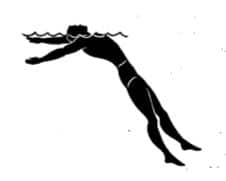
b. Most men are heavy legged, and cannot float in a horizontal position. To learn to float, stand in water about shoulder deep, take a full breath, lean backward gently, arch the back, tip the head backward, and raise the arms sideward and somewhat beyond the head. Then thrust the feet gently from the bottom and lie as relaxed as possible in the water. No attempt need be made to float horizontally, as the legs will rise if they are buoyant enough.
If the feet will not remain off the bottom of the pool, two things may be tried.
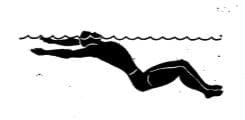
(1) Bend and separate lower legs and extend arms farther overhead in which case he may float satisfactorily.

(2) Move out into deeper water where it is possible to float vertically with only the face above water. This is not usually a satisfactory or comfortable position. Therefore, if it is impossible to float comfortably in the semi-horizontal or horizontal position; supplement the float with gentle arm or leg movements or both. The simplified leg movement is an alternate push with the soles of the feet. Extend the foot and push down from 8 to 12 inches. Then pull it back a bit with slightly bent knees, and again thrust out. This movement is much like walking up stairs with feet close together. The appropriate arm stroke is “finning.”
FINNING.
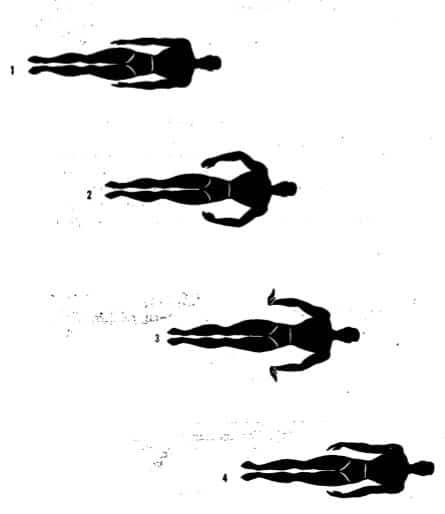
This is an arm movement which is used primarily on the back or in floating. First extend the arms along the sides. Then draw arms up about a foot and thrust the hands out and downward towards the feet in a pushing movement, supplemented by sort of fish tail flip of the hands and wrists. This movement can be amplified into a sculling movement.
SCULLING.

Lying on the back, start the sculling movement with the arms by pressing the hands outward with the wrist bent backward. The little finger is nearer the surface than the thumb. Then sweep the hands inward towards the thigh with the wrists still bent backward, but with the thumb closer to the surface. The movement is with the hand and wrist primarily. The range of motion is from 14 to 20 inches. It is like sculling with an oar. There is little lost motion.
ELEMENTARY BACKSTROKE.
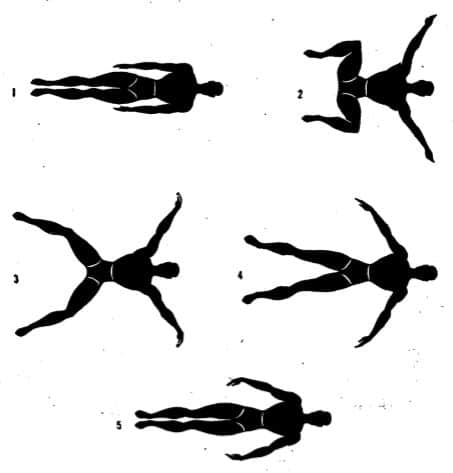
This stroke is one of the most useful in swimming. With it the inexpert swimmer can swim for a longer period of time than with any other stroke. It has the further advantage that the abdomen can be kept very close to the surface, which is of great importance to soldiers swimming in water under bombing attacks.
a. Arm movement. The arm stroke of the elementary backstroke may be of one of two types:
(1) The best method for military swimming is to swing the straight arms sideward and upward, palms down, with the little finger leading, and slightly nearer the surface than the thumb. When the arms are just beyond the shoulder level, turn the palm toward the feet and pull sidewards and downward to the thighs. The upward sweep of this stroke retards progress slightly, but it compensates by giving support to the back which, in military swimming, may be weighted down with a light pack, ammunition, metal helmet, etc.
(2) If the swimmer, in learning this stroke, tends to drop his hips, or if he is not weighted down with clothing or equipment, he may keep the elbows close to the sides, and perform a finning movement with his hands. The movement away from the body is exaggerated and is turned into a somewhat larger stroke. However, the stroke as outlined above in (1) is preferred and should be mastered as soon as possible.
b. Leg movement. The leg kick of the elementary back stroke is usually spoken of as the “frog kick.” Start with the legs straight, knees separated sideways, and bent. Throw the feet outward and backward with a strong inward rotation of the hip joint. Then thrust the feet out sidewards to a wide side-straddle position, with an accompanying outward rotation of the hip joint, until soles of feet face each other. Then bring the legs together forcefully. Do not raise knees any more forward than necessary. This is taught in four counts:
(1) The knee bend and leg separation.
(2) The leg extension.
(3) The pulling of the legs together.
(4) The glide.
The first three are later combined into one sweeping movement.
c. Coordination of arms and legs. In the elementary backstroke, start with arms by the sides and legs straight. Begin the preliminary movement of the arms and legs simultaneously and begin their stroking at approximately the same time. The leg stroke is completed earlier than the arm stroke; hence, the last part of the movement is with the arms. If the limited arm stroke is used, the arms and legs finish at the same time. The swimmer then glides for several feet. Inhale through the mouth on the upward movement of the arms, and exhale through the mouth and nose on the downward movement.
d. Land drills.
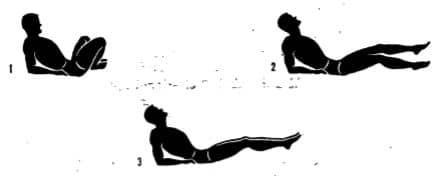
Practice in the coordination of arms and legs should be given before the men go into the water. The arm strokes should be practiced both standing and lying on the back. The leg stroke may first be practiced seated on the floor, leaning backward, and supporting the trunk on the elbow. This way they can see their leg movements. The movement of one leg can also be practiced while standing. If benches are available, each man may lie on his back on the bench and practice arm and leg movements at the same time. Standing, they can practice the movement on one leg and combine it with the arm movement.
e. Water drills. After men have developed confidence in the water and have learned to do the back glide, they should stand in water about 4 to 4 1/2 feet deep, push off backward, and begin by finning or by using the sculling arm stroke with the frog kick. Hips should be kept close to the surface. Head should not be so far backward that water runs into the nose. Arms should always be under water.
THE BREAST STROKE.
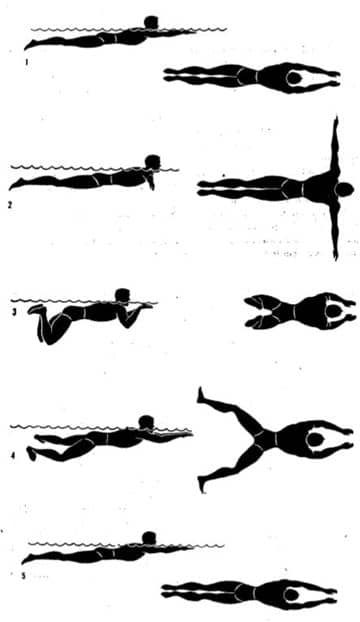
This is one of the most useful strokes for military swimming. It provides good visibility and is not too tiring. It is useful in swimming through debris and oil-covered waters, for swimming with clothing on or with a load, and for pushing a tired swimmer along with the tired swimmer’s carry. It is not an easy stroke to master, but it should be thoroughly learned.
a. Arm movement. The starting position is full extension in the water in the prone position. The head is up and the arms are pushed out ahead. Turn the-palms outward and pull arms outward, sidewards and slightly downward until the hands are opposite the shoulders and slightly below them. Then slice hands into the front of the shoulders and bring elbows against the sides. Thrust arms forward, with palms down and slightly outward. The hands should be thrust straight forward from the shoulders.
b. The leg kick. This is much like the frog kick on the backstroke. Draw knees up sideward, rather than forward. Let the heels trail until they reach the limit of the upward motion of the knees, which is near the limit of a thigh “split.” Then flex lower legs at the knees, lifting the heels higher than the hips. Thrust legs sidewards and outwards, and then squeeze them together. The soles of the feet should be facing as much as possible during the thrust and the squeezing action.
c. Coordination of arm stroke and leg kick. The whole stroke movement is in three counts.
(1) Begin arm pull, and near the finish of the pull, draw up the knees. The arm pull keeps the resistance created by the knees from slowing the swimmer’s progress unduly.
(2) As the arm pull is finished, and the hands are thrust forward, kick out the legs and then pull them together.
(3) Glide through the water until the momentum begins to fall off, then begin the next stroke.
d. Breathing. It is possible to breathe at any time in the breast stroke, but the usual way is to inhale through the mouth with the arm pull, and exhale through mouth and nose during the finish of the leg kick and the glide.
e. Body position. In swimming for speed, the trunk and legs must be near the surface. This position, however, is tiring. Swimming with the trunk and legs projecting diagonally back and down at an angle of from 20 to 35 degrees, is much slower, but is easier to sustain and not so tiring.
f. Land drill.
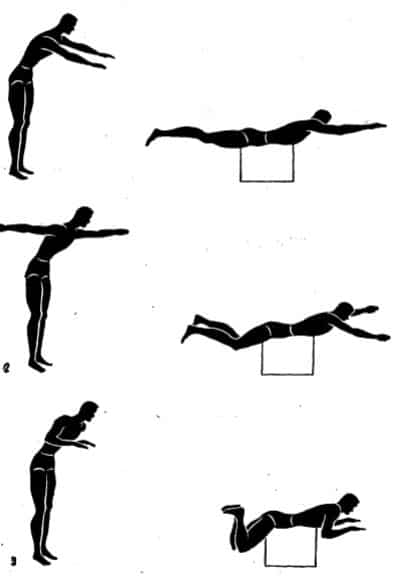
In land practice, the arm movement can be practiced in a standing position, with the trunk bent forward 9 degrees. If the men can lie on small benches, the whole stroke can be practiced. The leg kick can be practiced with one leg at a time, while standing, and combined with the arm stroke. Since the leg kick is so much like the backstroke frog kick the benefit of practicing the frog kick will carry over to the breast-stroke kick.
SIDE STROKE.
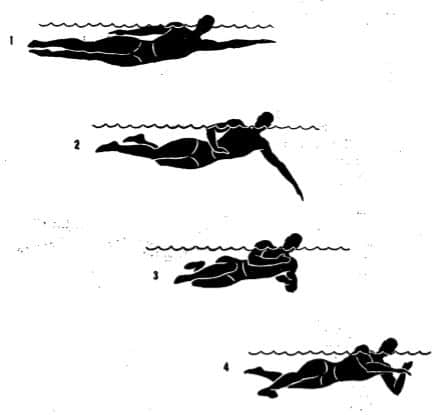
This stroke is easy to learn and to swim. With slight modifications it can be used for carrying others or when one arm is injured, or to carry a gun with the top hand out of water. The swimmer swims on one side. Usually he begins on the side that feels most natural. After learning on that side, however, he should learn to swim on the other side as well. As described below the stroke is executed on the left side. Those who swim on the right side will reverse directions.
a. Arm stroke. The starting position is lying on the left side. The left arm is extended in line with the body and beyond the head. The palm is down. The right arm is extended backward by the right thigh. Pull the left arm downward with elbow straight, and continue until it is straight down from the shoulder. Then flex the elbow and pull into the side. At the same time turn the palm toward the face. Then thrust forward to the original extended position. Bend the right arm at the elbow. Thrust the right hand upward in front of the chest, then push forward and downward in front of the chin or face. Here the right hand catches the water and pulls backward to its original position by the right thigh. The right hand starts forward just in-time to meet and pass the left hand at the neck or face. The coordination is as if the left hand were pulling a handful of water down and handing it to the right hand to carry it on to the end of its stroke.
b. The leg kick. This is the “scissors kick.” First the feet are drawn up, with the right in front about a foot, until the knees are bent to a right angle. Then straighten the right knee and the right foot is thrust forward, downward, and backward in a semi-circular sweeping motion. At the same time the left knee is straightened and the left foot is thrust backward, downward, and forward in a sweeping motion, resembling a kick. The double leg stroke resembles the closing of a pair of scissors cutting through a large piece of water. The right foot presents the sole to the water during the thrust, then point the toes back during the backward sweep. The left foot is extended throughout the stroke. The legs come together at the end of the stroke and remain in line with toes pointed downward during the glide.
c. Coordination of arms and legs. From the position of left arm extended forward, right arm by the right side, and legs straight and together, begin the stroke with the downward pull of the left arm. As this. arm pulls downward, start to thrust the right arm forward, and draw up knees to begin the kick. The catch and pull of the right arm and the kick of the legs, coincide with the completion of the pull of the left arm and its thrust forward to the gliding position.
d. The overarm side stroke. This stroke is exactly like the ordinary side stroke, except that the right arm recovers above the surface, and is thrust into the water in front of the face. This stroke is somewhat faster than the ordinary side stroke, but sinks the swimmer deeper in the water. This necessitates that he breathe rhythmically, inhaling with the pull and kick, and exhaling, usually under water, with the glide. This form of the stroke is somewhat more tiring, especially if the swimmer is clothed. It is useful swimming in rough water, however, and where more speed is required over a short distance.
e. Land drills. This stroke should first be practiced standing in a land drill. It can also be practiced on a bench. The coordination of the two arms is difficult at first and should be thoroughly understood before it is practiced in the water.
UNDERWATER SWIMMING.
Underwater swimming is particularly useful for escaping strafing attacks by planes, or rifle or machine fire from the shore. It is also used when swimming beneath blazing oil. (See FM 21-22.) Two methods of underwater swimming are commonly: used. These are identical with the breast stroke and the side stroke, except that the head is held straight forward.
a. A variation of the side-stroke is sometimes used. The pull of the right arm and the kick of the leg is identical, but the swimmer rolls somewhat on his face and performs a longer reaching stroke with his left arm. The stroke is halfway between the form for the side stroke and the Trudgen.
b. If swimming in water known to be clear of obstruction, a modification of the breast stroke can be used. In this stroke the arms pull clear through to the legs, and the glide is with arms by the sides. Usually, however, the arms should be ahead for protection.
TREADING WATER.
a. As soon as a man masters the frog-and scissors kicks and can swim the backstroke for 100 yards, he learns the methods of treading water. Those most commonly used are as follows:
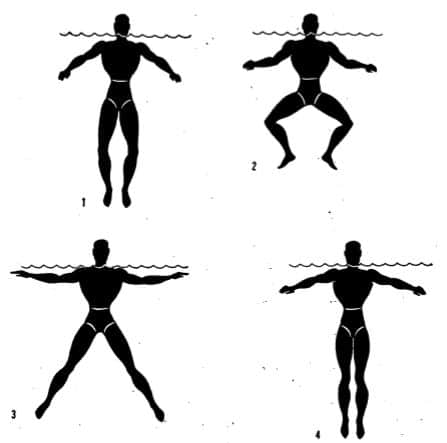
(1) Stand erect in the water and use the frog kick exactly as in the elementary backstroke. If necessary, use the arms to fin or scull.
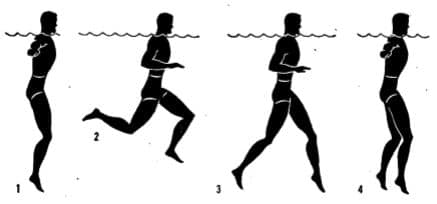
(2) Stand erect and use the scissors kick, either single or alternate (in the alternate kick, the left leg is forward in one kick and the right leg in the next kick). If necessary use arms to fin or scull at the same time.
(3) To stay afloat without using the legs, assume the position of the balanced or the vertical float, and scull with the hands.
TRUDGEN STROKE.
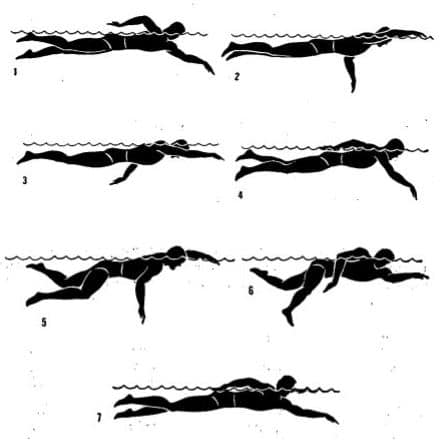
This is the hand-over-hand stroke which is most useful as a military speed stroke. It is the easiest to teach after the strokes presented above. This stroke is like the over-arm side stroke, except that the body rolls from left to right, and back again. The axis of the shoulders is at an angle of about 45 degrees to the water when the body is lying on the right side and chest, and at an angle of only about 20 degrees to the water when the body is on the left side.
a. Arm stroke. Start with the body on the left side, legs together, and arms as in the side stroke. Withdraw the right arm from the water and swing it forward above the surface of the water. Bend elbow slightly, and lead with the back of the wrist. Place the right hand in the water, palm downward, directly in front of the head, keeping elbow only slightly bent. At the same time the left arm has been pulling backward through the water and has about passed the left hip. Now bring the right arm down with elbow bent about 30 to 40 degrees from the straight line, until the hand comes under the midline of body. Then push back clear through to a position almost next to the right hip, then withdraw it from the water and begin a new stroke. The left arm stroke is the same as the right arm stroke and is timed to alternate with it. In slow swimming, each hand enters the water about the time the opposite hand passes the shoulder on the backward stroke. However, it does not begin to pull until the opposite hand passes the hip.
b. Leg kick. The leg kick is exactly the same as the scissors kick of the side stroke.
c. Coordination of arm stroke and leg kick. Begin the knee pull-up and the leg kick motion just as the right hand reaches in front of the right shoulder on its backward stroke. Complete the kick just as the right arm finishes the stroke and returns to the side. In swimming for speed, the arm motion is continuous, and there is practically no glide between strokes such as there is in the side stroke. In swimming for endurance, however, there is a rest in the position with the left arm forward, right arm backward, and legs together, and a short glide before the stroke is taken up again. The timing of this glide is exactly the same as in the overarm side stroke. The Trudgen stroke can be swum with the face in the water most of the time as in the crawl stroke.
FRONT CRAWL STROKE.

This is not usually considered a military stroke. It is primarily a racing stroke, but can be used by experts for swimming considerable distances. The arm movement of the crawl is easy to learn. The leg kick is very difficult to master in its best form, and is not useful for swimming with shoes on. It is included below primarily as a recreational stroke.
a. Body position and breathing. The body position of the crawl stroke is lying almost chest downward, and rolling slightly to each side. The face is kept in the water, about at the hair line, except when turning the head to inhale, or raising the head to look ahead. Inhaling may be done on either the right or left side. In the description below the swimmer will inhale on the right side. As the right hand comes out of the water, turn the head sharply to the right without raising it in the water, so that the chin is just forward of the right collarbone. Then inhale through the mouth. As the right hand enters the water, turn head to left and begin exhaling through nose and mouth. Finish the exhalation just before turning the head to the right again for the next inhalation. The roll to the left is not usually more than 20 degrees; however, the roll to the right may be as much as 30 degrees.
b. Arm stroke. The arms enter the water alternately just in front of the head. There are two commonly used forms of the arm stroke.
(1) This is the most commonly used form. Thrust the arm forward just above the surface of the water and out in front of the head. Let the arm rest in the water for a moment, just until the other hand is pulled out of the water. Then begin downward and backward stroke with the forward arm. This is the form used when swimming the crawl stroke for endurance, as it permits the coasting forward arm a moment of relaxation.
(2) The second form is used primarily for short distance sprinting. It is more powerful but more tiring than the form in (1) above. Thrust arm forward and downward into the water at an angle of 40 to 45 degrees to the surface. Arm enters just in front of the ear. Make the catch the instant the hand enters the water. Thrust each arm in the water before the other arm has pulled completely through. In this way the forward arm is about 45 degrees forward of a vertical line through the shoulder, the other arm is about 45 degrees behind the vertical.
(3) Regardless of which of the forms of the arm stroke used, the pull of the hand should be directly under the center of the body, and the elbow bent about 20 degrees from the straight line. When the hand passes the hip, withdraw the arm without completing the push backward to the thigh. The over-water recovery is much the same as for the Trudgen stroke. Throughout the arm stroke keep the palm of the hand as nearly at right angles to the surface of the water as practicable. That is, hook the wrist at the beginning of the stroke so the “paddle” surface of the hand is at right angles to the line of backward pull. Then adjust the wrist to keep the hand at right-angles to the surface of the water. This stroke is a sequence of “catch, press-and-pull, and push.”
c. Leg kick. When the crawl stroke is being learned, the legs simply thrash up and down over a narrow range from the knees, with toes pointed, the purpose being primarily to streamline the body in the water and prevent the legs from sinking. In the crawl as swum by experts, however, the legs thrash up and down from the hip in a very loose-jointed manner over a range which seldom exceeds 18 inches. The knee is straight until almost at the top of the up-stroke. The sole of the foot is at an angle of about 40 degrees to the surface of the water. As a leg starts its downward stroke, the knee bends about 30 to 35 degrees. The toes point backward and inward as much as possible. The whole leg moves downward in this position until the knee is below the knee of the opposite leg, then it is extended. In both the up-and-down strokes the legs are close together, the toes are “pigeon-toed,” and the knee and ankles are relatively loose. There is as much propulsion from the upward thrashing of the lower foot as there is from the downward thrash of the upper foot.
d. Coordination of arm stroke and leg kick. In almost all crawl stroke swimming, the feet execute six kicks to each complete double arm-stroke. As the left arm starts pressing downward at the beginning of the stroke, the right foot starts its downward kick. As the right foot goes up the left leg starts its kick. This is followed by a right kick. Just as the right arm begins its pull, the right leg starts up and the left leg kicks downward. This is followed by a right kick and then a left kick.
BACK CRAWL.
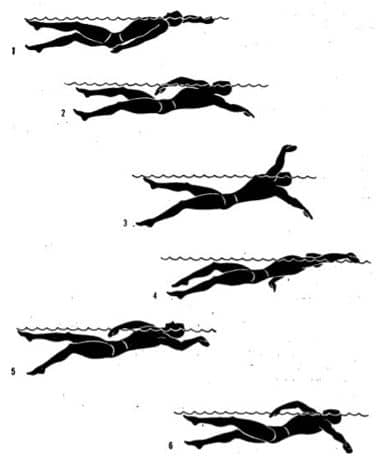
This is also a speed swimming stroke and not a military stroke.
a. Arm stroke. The position is on the back with arms extended-at the sides. Lift each arm alternately and place it in the water straight ahead of the shoulder on the same side. Then draw arm sideward and downward to the hip. Keep the hand about 6 to 12 inches below the surface of the water and the elbow straight. Bend the wrist so that the palm faces the direction of pull.
b. Leg kick. See kick for the front crawl.
ENTERING WATER.
In military swimming, the men usually enter the water either by walking or jumping in. There is very little diving. A shallow dive may be needed at times and surface diving should be mastered. Men should jump or dive only when any other entrance is impossible.
a. Jumping into the water.
(1) The stride jump. Enter the water with one leg forward and the other backward, much like the position of the scissors kick. If jumping from a low height, spread the arms sideward to prevent the head from going below the water level.
(2) Jumping from a height. Jump feet first, holding the nose with the thumb and forefinger of the left hand, and covering the mouth with the palm. In jumping without a lifebelt, and not into burning oil, extend the right arm overhead to aid in balance. If jumping with a kapok life jacket, encircle the left arm with the right arm, and grasp the left shoulder or top of the life jacket near that shoulder, to prevent the jacket from being forced upward and breaking the neck. If jumping through burning oil, without a life jacket, hold the right elbow in front of the eyes to protect them, and grasp the left shoulder with the right hand.
b. Shallow dive. Occasionally it is necessary to enter water of unknown depth rapidly. In such circumstances it is advisable to dive very close to the surface. The need for this type of entrance may accompany sudden enemy firing. If reaching the edge of the water on the run, dive outward almost parallel to the surface and enter the water with arms overhead, thumbs locked together, fingertips straight forward and palms down. Immediately upon entering, use the head and arms to control direction, whether upward or downward. An upward motion of the hands, arms, and head will result in a sharp rise to the surface. A downward motion will result in a deeper submerging.
c. Surface dive. When swimming on the surface, it is sometimes necessary to submerge quickly in order to swim under water. This may be done in two ways:
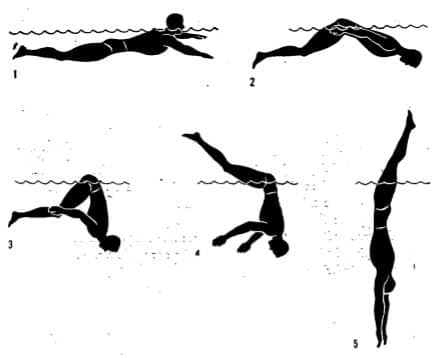
(1) Jackknife surface dive. Bend sharply at the hips, thrust arms overhead towards the bottom, and begin to swim with a breast stroke motion towards the bottom. This method is quick, but the legs usually project above the water as the swimmer submerges, and attract attention.
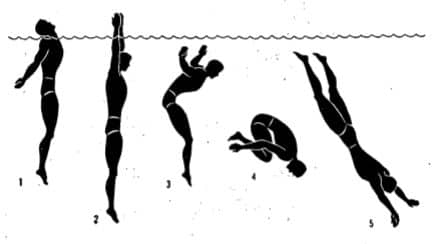
(2) Underwater surface dive. Drop the legs to the vertical with arms by the sides, and submerge with an upward double-arm sweep. Then, bend forward and start swimming forward. This method is practically noiseless.

